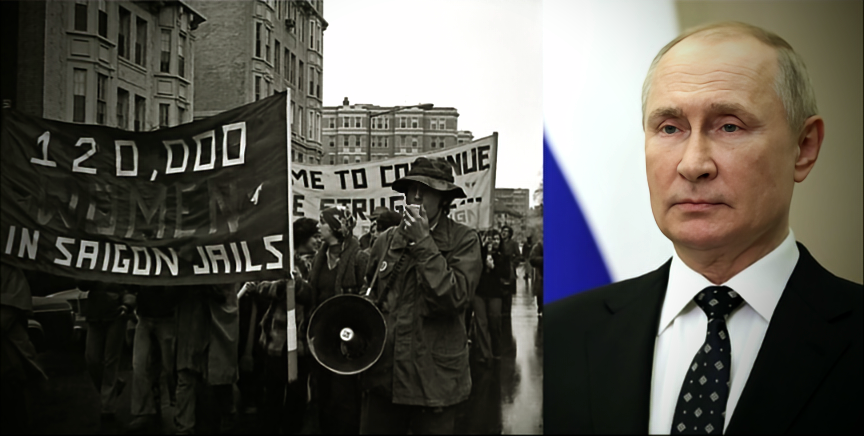 Commentary
CommentaryAs House Speaker Kevin McCarthy and his new Republican House majority threaten the pipeline of U.S. aid to Ukraine, more than one observer has noted the irony in the fact that the mantle of the antiwar cause has now been assumed by the right. The images of protestors being beaten outside the Democratic National Convention in Chicago in 1968, of hippies attempting to levitate the Pentagon in 1967, and many others, have long since seared themselves into the imagination of the American public, defining what it meant to be “antiwar.” Though these two movements would seem to have little in common at first glance, they actually share something deep. While some in both antiwar camps are merely objecting to what they see as a waste of U.S. resources that would be better spent at home, others are actually sympathetic to the adversary, be it Putin or the North Vietnamese, because they think that those adversaries share their own critique of the American state and American society. In other words, they think America’s cause is unjust and it deserves to lose, while America’s adversaries represent the healthy forces in the world fighting against American corruption and decadence. Unfortunately, as the example of Vietnam shows, U.S. adversaries know to echo existing critiques in order to weaken public support for the war, and it often turns out in the end that it was all just for show.
In September 1967, Tom Hayden, one of the founders of the Students for a Democratic Society and a leader of the antiwar movement, organized a conference in Bratislava, Czechoslovakia with a Vietnamese delegation led by Madame Nguyen Thi Binh, the foreign minister of the National Liberation Front of South Vietnam. Hayden was convinced that he and the NLF were fighting the same fight against American imperialism, telling them that “We are all Viet Cong now.” Hayden’s views were echoed by the leading Chinese foreign affairs journal which argued that “The victorious struggle of the Vietnamese people will also have a positive impact on the American domestic class struggle and development of its revolutionary movement.” Like many others in the New Left, Hayden believed that both the Vietnamese Communists and the protestors back in the US were fighting the same enemy – an imperialist colossus, the greedy “military-industrial complex” that was the enemy of freedom-loving peoples everywhere.
This was no accident. As early as the beginning of 1965, historian Pierre Asselin writes, Hanoi had charged the NLF with “fueling antiwar sentiment in North America and Western Europe.” A year later, the ruling party of North Vietnam directed its foreign propaganda apparatus to exploit “all the forces and all the public opinion of the world’s people, including the American people, to [make them] agree with and support our people’s anti-American cause for national salvation.” Doing this meant building bridges to the American left and convincing them that they and the North Vietnamese were in the same fight. As the North Vietnamese Culture Minister Hoang Minh Giam told Black Panther leader David Hilliard at the Hemispheric Conference to End the War in Vietnam, “You are Black Panthers. We are Yellow Panthers.”
Today Vladimir Putin poses as the scourge of all that the Trumpist right hates: wokeism, globalism, political correctness, identity politics, and cancel culture, calling teaching children about gender fluidity a “crime against humanity.” It is again no accident that his critique of the West matches that voiced by many in the West dissatisfied with the direction of its leading institutions and many of its leading politicians. It is directed toward sowing division within Western political ranks, and to some degree, it is succeeding. As Josh Hawley tweeted to his fellow Republicans “You can either be the party of Ukraine and the globalists or you can be the party of East Palestine and the working people of America.” Now, like then, a significant political faction inside the United States has convinced itself that the real enemy is those who hold power in Washington and leading American institutions, and a like-minded savior has arisen abroad to slay the American colossus.
Now, as before, however, those who think this way will likely be disappointed. When the North Vietnamese army finally marched into Saigon in April 1975, they came not to liberate, but to conquer. Instead of a democratic state governed by the parties of the National Liberation Front as envisioned by many antiwar protestors, the North Vietnamese leaders annexed the South and created a unified communist state ruled from Hanoi, initiating a reign of terror that forced hundreds of thousands to flee the country. Some antiwar protestors realized their mistake in hoping for an NLF victory, though Tom Hayden, for one, did not. It must be said that Vietnam and Ukraine are not the same. For one, American troops are not fighting in Ukraine. It must also be said that there are elements of both critiques of America that have merit, and the critique of the left then and of the right now even have points in common. But the identification of those critiques with a foreign aggressor is misguided, and will ultimately end in disillusion.
Jeremy Friedman is the Marvin Bower Associate Professor of Business Administration at Harvard Business School. A historian of Russia, he has published two books on Cold War history, including most recently Ripe for Revolution: Building Socialism in the Third World (Harvard University Press, 2022).
Suggested citation: Jeremy Friedman, How Putin Uses Hanoi’s 1960s Playbook to Divide the American Public on Foreign Policy, JURIST – Academic Commentary, March 16, 2023, https://www.jurist.org/commentary/2023/03/how-putin-uses-hanois-1960s-playbook-to-divide-the-american-public.
This article was prepared for publication by JURIST Commentary editors. Please direct any questions or comments to commentary@jurist.org

